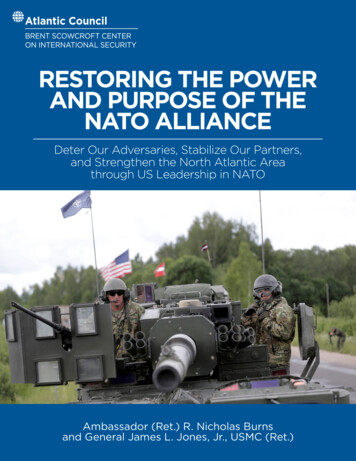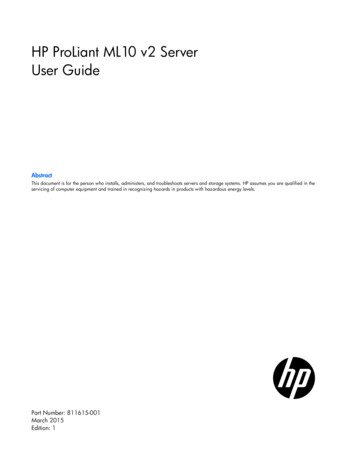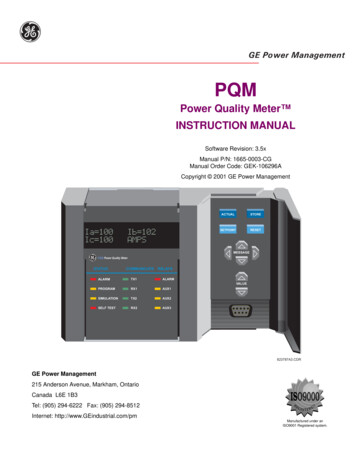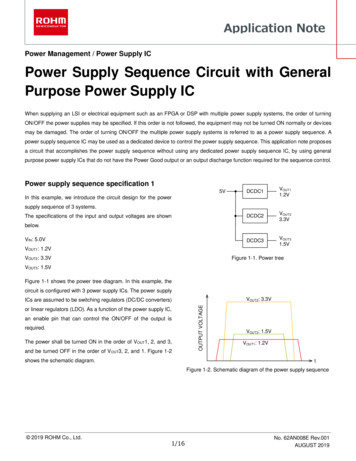
Transcription
RESTORING THE POWERAND PURPOSE OF THENATO ALLIANCEDeter Our Adversaries, Stabilize Our Partners,and Strengthen the North Atlantic Areathrough US Leadership in NATOAmbassador (Ret.) R. Nicholas Burnsand General James L. Jones, Jr., USMC (Ret.)
RESTORING THE POWERAND PURPOSE OF THENATO ALLIANCEDeter Our Adversaries, Stabilize Our Partners,and Strengthen the North Atlantic Areathrough US Leadership in NATOAmbassador (Ret.) R. Nicholas BurnsR. Nicholas Burns is a board director at the Atlantic Council and the Roy and Barbara Goodman FamilyProfessor of the Practice of Diplomacy and International Relations at the Harvard Kennedy School ofGovernment. Previously, he served as the US Permanent Representative to NATO.General James L. Jones, Jr., USMC (Ret.)General James L. Jones is chairman of the Brent Scowcroft Center on International Security and aboard director at the Atlantic Council. He is the founder and president of Jones Group International.Previously he served as National Security Advisor to President Barack Obama, Supreme AlliedCommander Europe for NATO, and Commander of US European Command.Project Facilitator: Damon WilsonProject Rapporteur: Jeff LightfootISBN: 978-1-61977-472-8Cover photo credit: REUTERS/Ints Kalnins.This report is written and published in accordance with the Atlantic Council Policy on IntellectualIndependence. The authors are solely responsible for its analysis and recommendations. The AtlanticCouncil and its donors do not determine, nor do they necessarily endorse or advocate for, any of thisreport’s conclusions.June 2016
Table of ContentsEXECUTIVE SUMMARY. 1INTRODUCTION. 5WHAT’S AT STAKE:AMERICA’S ENDURING INTEREST IN A STRONG, UNITED EUROPE. 7THE STRATEGIC CONTEXT:NATO’S UNSTABLE PERIPHERY UNSETTLES EUROPEAN ALLIES. 8RESTORING THE ALLIANCE THROUGH US LEADERSHIP:FROM A REACTIVE TO A PROACTIVE ALLIANCE. 12RECOMMENDATIONS.14ABOUT THE AUTHORS. 17
RESTORING THE POWER AND PURPOSE OF THE NATO ALLIANCEExecutive SummaryAs NATO leaders prepare to meet in Warsaw thisJuly, the Alliance faces the greatest threat to peaceand security in Europe since the end of the Cold War.Transatlantic leaders must confront a jarring reality:the peace, security, and democratic stability ofEurope can no longer be taken for granted. Thetransatlantic community faces four fundamentalstrategic challenges—a revanchist Russia, erodingstability in the greater Middle East, a weakenedEuropean Union, and uncertain American andEuropean leadership—that threaten the entirecommunity, and by extension global security.What NATO needs most is determined politicalleadership backed by a long-term strategy torestore its power and purpose. NATO leadersshould agree at their NATO Summit in July on anambitious set of measures to deter Russia, stabilizethreatened allies and partners to NATO’s east andsouth, and strengthen the military capacity of theAlliance in the coming year. NATO nations mustresolve, as they did in 1949, to protect and defendEurope and the rules-based international orderfrom these challenges.To its credit, the NATO nations have begun torespond to these challenges. Allies are graduallymoving more forces and equipment to NATO’seastern flank to better deter Russian aggression.The Alliance is delivering on its commitment to fielda missile defense program to defend its territory. TheUnited States has led impressively by securing morethan 3 billion in funds to bolster NATO’s militarycapacity in Europe’s East. This must now be met byan equivalent effort by European militaries. Whilesome allies are reversing the harmful redirectionsin defense spending in past years, this progress isstill dramatically insufficient. NATO is maintainingits commitment in Afghanistan and has launched amission in the Aegean to strengthen cooperation inthe region and to help stem the flow of refugees toAT L A N T I C C O U N C I LEurope. All of these steps have revived NATO andstrengthened its collective defense.But these NATO actions are not sufficientlyambitious to meet the extraordinary challengesbefore us. NATO needs more consistently strong,determined American presidential leadership.It needs a stronger Germany with a military tomatch its political and economic weight. It needsthe United Kingdom (UK), France, Italy, and otherEuropeans allies to contribute much more to ourcollective defense. NATO needs to build strongerstrategic deterrence against Russia.Allied leaders must respond to this fundamentallychanged security environment by agreeing to muchmore ambitious measures to rebuild the Alliance.To restore NATO’s power and purpose, NATOallies should: Build up NATO’s military presence in theBaltic states, Poland, and Black Sea Region.At this July’s NATO summit, NATO nationsshould decide to shift a far greater proportionof NATO forces and capabilities to its easternallies, including the permanent stationing ofland, air, and sea forces in the Baltic states,Poland, Romania, Bulgaria, and in the Arcticas long as Russia maintains its aggressiveposture. Deploying four rotational battalionsto the Baltic states and Poland, a decisionagreed upon at the NATO Defense Ministersmeeting in June 2016, started importantmomentum on this front, but permanentbasing and the development of additionalinfrastructure will be integral for NATO’s longterm posture in the east.¡¡NATO leaders should reaffirm NATO’sfundamental purpose—to advance anddefend a Europe “whole, free, and at peace”at a time of renewed danger.1
RESTORING THE POWER AND PURPOSE OF THE NATO ALLIANCE¡¡¡¡¡¡¡¡ Similarly, the Alliance should continue todevelop, deploy, and integrate collectivemissile defense and accelerate cybercapabilities based in the east.NATO should undertake to create a NATOmaritime mission in the Black Sea region—led by Romania, Bulgaria, and Turkey andincluding partner countries Georgia andUkraine—as a response to Russia’s illegalannexation and subsequent militarizationof the Crimean peninsula.2NATO should recognize the renewedimportance of the so-called “GIUK Gap,” thestrategic Cold War choke point in the NorthAtlantic between Greenland, Iceland, and theUK from which Russia could project its navalpower and raise tensions with NATO throughclose-call overflights, airspace incursions, andmock attacks. This could become a new zoneof contention between Russia and NATO asRussia ramps up its military presence in theArctic. To protect Alliance interests, NATOshould return anti-submarine warfare andintelligence monitoring capabilities to Iceland,a vital waypoint between North Americaand Europe and an important linchpin forNATO’s presence in the North Atlantic.Taken together, these measures shouldleave no doubt in Moscow of NATO’s willand capability to ensure the credibility of itsArticle 5 collective defense commitment,regardless of the nature of the attackagainst an ally (e.g., conventional, cyber, orhybrid attack).In sum, NATO allies must continue to holdthe line against Russian aggression until anew generation of Russians agree to livein peace with its neighbors in central andEastern Europe.Commit to greater military spendingamong NATO allies. In Warsaw, each of theEuropean allies and Canada should reaffirmtheir pledges to meet the NATO target of2 percent of GDP on defense expendituresby seeking parliamentary ratification of thiscommitment with specific plans on how toreach the target within the next five years.Germany, Italy, Spain, and the Netherlands,in particular, should match the commitmentsmade by the UK, Romania, France, Poland,and Turkey to move toward the 2 percentlevel. European defense spending is stillwoefully inadequate and not commensuratewith the security challenges on thecontinent. Germany must take the lead inthis recovery of Europe’s military strength.NATO also must take more expansive steps tostrengthen its collective defense against thefull range of cyber threats. In the Arctic, NATO’s littoral and coastalstates—Canada, the United States, Norway,Denmark, and Iceland—must work to expandtheir surveillance and search and rescuecapability. This is an area where NATO canoffer to work with Russia peacefully tominimize future disagreement and conflict.Keep the pressure on Moscow. AtWarsaw, NATO allies should reaffirm theircommitment to maintain sanctions onRussia over its egregious violations ofUkrainian sovereignty. And NATO nationsshould transfer lethal defensive armamentsto Ukraine so that it can defend its border.NATO should keep the diplomatic lines opento Russia through regular meetings of ourambassadors and military leaders, throughexercises, and summit meetings. Stay the course in Afghanistan. NATO alliesmust remain committed to the government andpeople of Afghanistan by agreeing to retaintheir forces there indefinitely with no furtherreduction in numbers for the foreseeablefuture. This would constitute a strong signalto the Taliban and other extremist groups thatNATO will stand by its commitment to theAfghan government and people. Extend greater support to NATO’s Arabpartners. Expand substantially NATO’straining role in the greater Middle East aining and defense capacity buildingmissions in Iraq, Tunisia, and in support ofthe new government in Libya;expanding defense cooperation with longtime NATO partners Morocco and Jordan;forging a cooperative security agreementbetween NATO and the Gulf CooperationCouncil to include the adoption of commonstandards to ensure interoperability for jointAT L A N T I C C O U N C I L
RESTORING THE POWER AND PURPOSE OF THE NATO ALLIANCEThe North Atlantic Council convenes in December 2015. Photo credit: NATO/Flickr.the only way to sustain increased defenseinvestments and therefore:exercises and common efforts to enhancecyber and missile defense capabilities; and¡¡ NATOshouldenhanceitscivilianand military intelligence sharing andcoordination, among allies and with keypartners in the Middle East and NorthAfrica, to help prevent and respond toterrorist threats. Terrorist attacks onmember states directed by the IslamicState of Iraq and al-Sham (ISIS) shouldbe considered an attack on NATO thatrequires a united response from all allies.NATO must demonstrate its relevanceto its member states’ citizens in the faceof this enduring strategic challenge thatconcerns all allies alike.Link economics and security. Recognize thatrestoring economic growth and prosperityis a strategic imperative for the Alliance andAT L A N T I C C O U N C I L¡¡ Recommit in all NATO countries to strengthenour collective democratic foundation.¡¡ Renew NATO nations’ commitment tofinalize negotiations for the TransatlanticTrade and Investment Partnership (TTIP)as a geostrategic imperative. This must bea top priority for the next US president.NATO leaders in Hungary, Poland, andTurkey, in particular, must demonstrate theircommitment to ensure the full freedomsand civil liberties of their citizens.Restore strong American leadership. Inthe United States, the next president hasa particular responsibility to rebuild publicsupport for NATO. To do so, the United Statesshould continue to lead in strengthening the3
RESTORING THE POWER AND PURPOSE OF THE NATO ALLIANCEAlliance to ensure it is capable of meetingthe challenges of an evolving securityenvironment, and other Allies shouldmeet their commitments to invest more intheir own defense. In a collective defensealliance, allies should hold each otheraccountable to meet their commitments.However, NATO is not a ‘burden’ on theUnited States, but rather a force multiplierfor US power and influence around theworld. The Atlantic alliance underpins thesecurity, stability, prosperity, and freedom ofthe entire North Atlantic area and anchorsthe global security system that the UnitedStates established after World War II.While US allies can and should contributemore to their own defense, demagogicattacks on US alliances only strengthencommon adversaries. Asserting that NATOis “obsolete” does deep damage to Allianceunity and solidarity. To make this argument,as has happened this presidential electioncycle, is to mislead the American people anddenigrate the sacrifices of American allies.America’s global network of alliances is one ofour greatest strategic assets and advantagesover nations such as Russia or China. Thecontributions of US allies to regional and globalsecurity and prosperity mean significant costsavings for the United States. 4Counter those who threaten to withdrawUS support for NATO. Across the Alliance,governments are challenged at home bynativism, populism, and rising isolationism.NATO cannot succeed if its leaders donot stand up for the democratic valuesandpowerfultransatlanticsolidaritythat have united us for seven decades.The United States and its allies cannot be safeand prosperous in a globalized world if theydo not exert international leadership throughtheir alliances and partnerships. If the UnitedStates shapes the future constructively withits allies and friends, democratic freedomsin the world will thrive. If we fail to do so,less benevolent forces will fill the void.We believe that extending NATO and theEuropean Union (EU) membership to thecountries of the former Warsaw Pact wasamong the most important decisions theAlliance has ever taken. Through NATOand EU expansion, we helped to safeguardthe liberties and freedoms of central andEastern Europe. We helped to forge amore united, democratic Europe. Theseare goals that all post-World War II USpresidents have embraced. And, we remainconfident that with strengthened American,Canadian, and European leadership, NATO’spower and purpose can be restored forthe benefit of our 500 million citizens.As former NATO secretaries general,ambassadors,militaryofficers,andsupporters of our great Alliance, we areconcerned by the enormity of challengesNATO faces in 2016 and the years to come.We remain committed to the strategicaim that we agreed to when Germanywas reunified and the Cold War endedin a democratic peace twenty-five yearsago—a Europe “whole, free, and at peace.”That is a goal worthy of our Alliance and ofdefending with our collective strength.AT L A N T I C C O U N C I L
RESTORING THE POWER AND PURPOSE OF THE NATO ALLIANCEIntroductionThe next president of the United States must leadin the restoration of NATO’s power and purpose todefend Europe and North America from the mostserious security challenges since the end of theCold War.Transatlantic leaders must confront a jarring reality:the peace, security, and democratic stability ofEurope can no longer be taken for granted. Thetransatlantic community faces four fundamentalstrategic challenges—a revanchist Russia, erodingstability in the greater Middle East, a weakenedEuropean Union, and uncertain American andEuropean leadership—that threaten the entirecommunity, and by extension global security.Russia is no longer a partner, asmany hoped it would becomewith the collapse of communisma quarter century ago. Today, anassertive and predatory Russia isre-dividing Europe from the Gulfof Finland to the Black Sea andbeyond. Vladimir Putin aims toroll back western influence anddemocratic values in Europe.Russia’saggressivemilitaryactions in Ukraine and Crimeaand threats to Eastern Europeconstitute the single greatest challenge to theAlliance since the Cold War.the modern European Union. Finally, the UnitedStates has shown uncertain leadership of NATOover the last decade. American political leaders ofboth political parties and from both the executiveand legislative branch have referred to allies as a“burden” rather than the asset they clearly are andhave gradually shunted NATO away from a centralrole in US foreign policy.In the face of these four new strategic challenges, theUnited States and Europe must resist the temptationto turn inward and adopt a fortress mentality. TheNorth Atlantic area is prosperous, secure, and freebecause it is the world’s most integrated and openspace of free markets, free ideas, and free people.Preserving these foundations isthe highest strategic priority ofwestern democracies.The next presidentof the UnitedStates must lead inthe restoration ofNATO’s power andpurpose. . .The rise of the Islamic State of Iraq and al-Sham(ISIS) and the breakdown of order in Iraq andSyria have unleashed a tragic human tidal wave ofrefugees and a wave of terrorist attacks on westernEurope, Turkey, and across the globe. These externalshocks have undermined European cohesion, pittedEU members against one another, and fueled agroundswell of anti-establishment, populist anger.There is a very real risk that the breakdown of orderin the Middle East could result in the unraveling ofthe unity and principles that are the foundation ofAT L A N T I C C O U N C I LIt would be strategic folly forthe United States to forsakeor neglect the rich network ofalliances and friendships thatunderpin its global leadershipand power. Alliances are strategicassets that expand and magnifyAmerican power. Competitorssuch as Russia, China, or Iran canonly dream of having a rich, loyalnetwork of allies who support their interests andshare their values around the world. Thus, criticismsof NATO and threats to dismantle it are unwiseand dangerous.NATO is a permanent political and military allianceand the primary vehicle through which the UnitedStates exercises influence in Europe and projectspower in the North Atlantic. NATO is the largestcollection of US allies in the world and comprisesAmerica’s most important trading and investmentpartners. NATO anchors the North Atlantic area tosupport freedom and prosperity in an uncertainworld. NATO also underpins the global security5
RESTORING THE POWER AND PURPOSE OF THE NATO ALLIANCEorder, which the United States has worked to sustainas one of the highest foreign policy ambitions sinceWorld War II.The Alliance thus must act to restore its power andunity following Russia’s hostile actions in Ukraineand Europe’s East. At the 2014 NATO Summit inWales, the United States and its allies reassurednervous eastern European allies and vowed tostem the decades of defense cuts that had leftthe Alliance underfunded and hollowed out.Yet the steps taken at Wales and their aftermathare woefully insufficient in the face of a moreaggressive Putin, a weakened Europe, and adestabilized Middle East. At the Warsaw Summitthis July and as a new US administration takesoffice in January 2017, the United States mustrecommit to its unquestioned leadership role andrally its allies to take much more ambitious effortsto restore NATO’s power and purpose.The United States should start by placing NATOonce again at the center of US strategy in Europe.For too long—and under both political parties—theUnited States has shifted NATO to the margins ofits attention. Too often, US officials have describedand treated NATO as “them,” when in reality it is analliance of which the US is a founding member andthe natural leader. The United States can no longerafford to be ambivalent about leadership in NATO.The next president should make it a priority andexercise personal leadership in the Alliance.US leaders deserve credit for committing tostrengthen the US military presence in easternEurope with the 3.4 billion European ReassuranceInitiative (ERI). The United States must sustainthis effort in the coming years. The Congressshould work with the administration to put thisfunding into the base defense budget to ensure itspermanence in the face of the long-term Russianthreat we face. The next US administration shouldcontinue the surge of US military assets back intoEurope, including heavy brigades on the Easternflank to rebuild our capacity to defend NATO anddeter Russia.6Europeans must do their part as well. Currentdefense spending levels in most allied countriesare unacceptably low. All allies should commit atWarsaw to meeting NATO’s 2 percent target ofGDP allocated to defense by 2020. It is particularlyimportant for large allies like Germany, Spain, andItaly—which have significant capacity and militarycapability—to move toward greater defenseinvestment. European allies must make their ownnew commitments to deterrence and forwarddefense in Eastern Europe. Allies should matchUS rotations of troop brigades in Northern andEastern Europe at a 1:1 ratio. Beyond the WarsawSummit, NATO must abandon its outdatedreluctance to building new infrastructure andpermanent NATO forces in eastern Europe anddispel any doubt that the allies will take allnecessary measures to deter external threatsfrom every inch of Alliance territory.Missile defense is an integral component of NATO’sforce posture and deterrence. The current missiledefense architecture is aimed at threats emanatingfrom the Middle East, but has taken on addedpolitical importance given Russia’s nuclear saberrattling and newly aggressive posture in Europe.The United States should work with its allies toensure NATO’s missile defense architecture and anyfurther missile defense developments remain highlyhoned, interoperable, effective, and under Alliancecommand and control. Sustaining this robustmissile defense system would strengthen NATO’sdeterrence posture against Russia and undercut itsefforts to create new anti-access/area-denial (A2/AD) bastions that penetrate Alliance territory.Finally, the United States and Europe mustfinalize negotiations on the Transatlantic Tradeand Investment Partnership. The next presidentand Congress should move to ratify it. Linkingthe transatlantic economy—by far the largest inthe world—in a space of common regulations andstandards would strengthen the North Atlantic areaat a time of great challenge.AT L A N T I C C O U N C I L
RESTORING THE POWER AND PURPOSE OF THE NATO ALLIANCEWhat’s at Stake: America’s EnduringInterest in a Strong, United EuropeThe United States has a direct stake in Europe’ssecurity, prosperity, and freedom. Since PresidentTruman committed the United States to NATO in1949, the United States has understood that afree and democratic Europe, allied to the UnitedStates, is a vital American interest, fundamentalto the preservation of the contemporary globalsecurity order we led in creating. After twice havingto come to Europe’s aid during the twentiethcentury through the bloodiest wars in history,every American president forsix decades has understood theadvantages of investing in andpreserving Europe’s peace.who work with the Alliance in Afghanistan, theMediterranean, and the Baltic Sea. It also offers acontinent-sized forward operating base from whichthe United States can launch and support majormilitary operations in the Middle East, Asia, andacross the globe. Particularly in a world of greatuncertainty, turbulence, and rising authoritarianism,the NATO Alliance is an essential asset for both theUnited States and Europe.But that asset cannot bepreserved and sustained withoutmuch greater political andfinancial investments. During thelast two decades of relative calmand prosperity, it was sometimeseasy to assume Europe would nolonger face existential securitythreats as it had throughout thetwentieth century. Europe facedno peer competitor or strategicchallenges. It appeared that aEurope “whole, free, and at peace,” as PresidentGeorge H.W. Bush so memorably called it, was thenew normal. Freedom was on the march. In thisrelatively benign atmosphere, the United States wasable to focus on other challenges in the Middle Eastand East Asia. In the absence of a peer competitor,European countries made substantial cuts to theirdefense budgets, ended conscription, and allowedtheir military capacity to atrophy.Thanks to NATO, asignificant part ofthe globe is stable,democratic, and atpeace.What a great bet that has turnedout to be. The transatlanticalliance has paid huge dividendsfor the United States in aglobalized world, just as it didin the Cold War. Europe is theUnited States’ largest tradingpartner, largest investor, and an engine of USprosperity and job creation. Through NATO, Europeserves as America’s most important and capableroster of military allies capable of fighting withUS forces. Europe’s shared commitment to humanrights, democracy, and rule of law underpins theliberal international order that is the centerpiece ofAmerican strategy.NATO is a remarkable asset to American foreignpolicy. The North Atlantic alliance defends stabilityfrom Alaska, British Columbia, and California in theWest to the Baltic states in Eastern Europe andsouth to Turkey on the border of the Middle East.Thanks to NATO, a significant part of the globeis stable, democratic, and at peace. NATO offersthe United States twenty-seven fellow allies whoshare our broad political goals and objectives,and a network of sixty partners around the worldAT L A N T I C C O U N C I LAs a result, the European Union is overwhelmedby its external and internal crises. And the NATOalliance—which buttresses the European project—isscrambling to catch up to a newly hostile strategicenvironment after years of defense spending cutsand inattention from key member states such asGermany, Italy, Spain, and the Netherlands.7
RESTORING THE POWER AND PURPOSE OF THE NATO ALLIANCEThe Strategic Context: NATO’sUnstable Periphery UnsettlesEuropean AlliesThe Russian Threat to Europe’s Northand EastRussia is the primary cause of this new threat toNATO. Russia’s illegal annexation of Crimea in 2014,its cynical war that divided Ukraine, and its supportfor the murderous Assad regime in Syria underminethe liberal international order and endanger securityin both Europe and the Middle East.At the Munich Security Conference in February2016, Russian Prime Minister Dmitry Medvedev said“Speaking bluntly, we are rapidly rolling into a periodof a new cold war.” Following the conference, manyanalysts and observers were quick to downplayor dismiss his comments. But allies should not befooled. President Putin is a former KGB operativeand has made his views on NATO very clear. Hesees NATO as his adversary and the collapse ofthe Soviet Union as the greatest catastrophe ofthe twentieth century. Allies should be crystal clearabout the threat at hand and take Prime MinisterMedvedev at his word.Moscow aims to undermine the law-based principlesof European security and the liberal internationalorder that the United States and its European alliesfirst established in the aftermath of World War II andexpanded after the fall of the Berlin Wall. It is notjust the NATO countries who have an interest in thepreservation of this international system. Democraciesand law-based societies around the world have astake in preserving the global security order.Given its hostile intent, Russia’s 700 billion militaryinvestment is a cause for concern and a key reasonUS military officials repeatedly identify Russia,once again, as America’s greatest existential threat.Alliance officials express particular concern aboutRussia’s ability to deter NATO from responding toan Article 5 violation in Europe’s East. An imbalanceof Russian firepower in Kaliningrad, illegallyannexed Crimea, and Syria may provide Russiaan A2/AD capability. This would prevent NATO8militaries from operating with freedom, even withinAlliance territory. This creates strategic imbalanceon the Continent.Russia’s A2/AD capabilities are particularlyconcerning given Russia’s new military tactics inEurope, from provocative snap military exerciseswith up to 100,000 troops to hybrid warfare, whichit has adopted and perfected in Ukraine and Syria.In Syria, Russia demonstrated its ability to projectpower in the Middle East and put its modernizingmilitary to the test in combat. And in the BalticSea and Black Sea regions, Russian jets have takento the irresponsible and dangerous practice of“buzzing” allied warships operating in internationalwaters in an attempt to intimidate NATO fromconducting legitimate freedom of maneuveroperations. Coupled with its ability to deny accessto NATO militaries in theaters where it had onceenjoyed supremacy, this presents a grim picturefor transatlantic defense planners for any futuremilitary operation.Russia’s threat to the Baltics and Poland is welldocumented. But the threat of an accidentalconflict between NATO and Russia is just as high inthe Black Sea region, where NATO allies Romania,Bulgaria, and Turkey are situated. The Russianthreat to NATO’s southeastern flank was largelyoverlooked until Russia’s military build-up in Syria inlate 2015 to support the forces of President Basharal-Assad. Russia’s competition with NATO memberTurkey over the future of northern Syria has alreadyresulted in the Turkish shoot-down of a Russianfighter and a dramatic rise in tensions betweenMoscow and Ankara. Russia’s recent militarizationof illegally-annexed Crimea is of great concern toallies such as Turkey, Bulgaria, and rtiveness is also a challenge in the Arcticregion and the high north. As part of its militarymodernization, Russia has established an ArcticAT L A N T I C C O U N C I L
RESTORING THE POWER AND PURPOSE OF THE NATO ALLIANCEstrategic command and developed new, or hasrevived and modernized former Cold War, militarybases in the region. The Arctic is also home toRussia’s powerful Northern Fleet, which is currentlybeing modernized and includes Russia’s seabased nuclear deterrent. Russia’s revised mariti
RESTORING THE POWER AND PURPOSE OF THE NATO ALLIANCE ATLANTIC COUNCIL 1 Executive Summary As NATO leaders prepare to meet in Warsaw this July, the Alliance faces the greatest threat to peace and security in Europe since the end of the Cold War. Transatlantic leaders must confront a jarring










